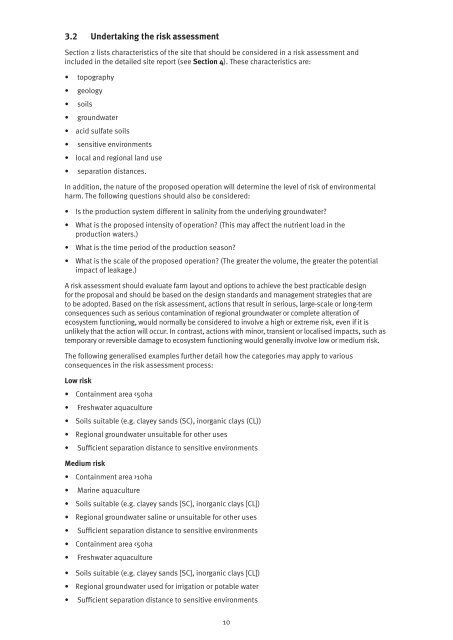Guidelines for constructing and maintaining aquaculture ...
Guidelines for constructing and maintaining aquaculture ...
Guidelines for constructing and maintaining aquaculture ...
You also want an ePaper? Increase the reach of your titles
YUMPU automatically turns print PDFs into web optimized ePapers that Google loves.
3.2 Undertaking the risk assessment<br />
Section 2 lists characteristics of the site that should be considered in a risk assessment <strong>and</strong><br />
included in the detailed site report (see Section 4). These characteristics are:<br />
• topography<br />
• geology<br />
• soils<br />
• groundwater<br />
• acid sulfate soils<br />
• sensitive environments<br />
• local <strong>and</strong> regional l<strong>and</strong> use<br />
• separation distances.<br />
In addition, the nature of the proposed operation will determine the level of risk of environmental<br />
harm. The following questions should also be considered:<br />
• Is the production system different in salinity from the underlying groundwater?<br />
• What is the proposed intensity of operation? (This may affect the nutrient load in the<br />
production waters.)<br />
• What is the time period of the production season?<br />
• What is the scale of the proposed operation? (The greater the volume, the greater the potential<br />
impact of leakage.)<br />
A risk assessment should evaluate farm layout <strong>and</strong> options to achieve the best practicable design<br />
<strong>for</strong> the proposal <strong>and</strong> should be based on the design st<strong>and</strong>ards <strong>and</strong> management strategies that are<br />
to be adopted. Based on the risk assessment, actions that result in serious, large-scale or long-term<br />
consequences such as serious contamination of regional groundwater or complete alteration of<br />
ecosystem functioning, would normally be considered to involve a high or extreme risk, even if it is<br />
unlikely that the action will occur. In contrast, actions with minor, transient or localised impacts, such as<br />
temporary or reversible damage to ecosystem functioning would generally involve low or medium risk.<br />
The following generalised examples further detail how the categories may apply to various<br />
consequences in the risk assessment process:<br />
Low risk<br />
• Containment area 10ha<br />
• Marine <strong>aquaculture</strong><br />
• Soils suitable (e.g. clayey s<strong>and</strong>s [SC], inorganic clays [CL])<br />
• Regional groundwater saline or unsuitable <strong>for</strong> other uses<br />
• Sufficient separation distance to sensitive environments<br />
• Containment area

















